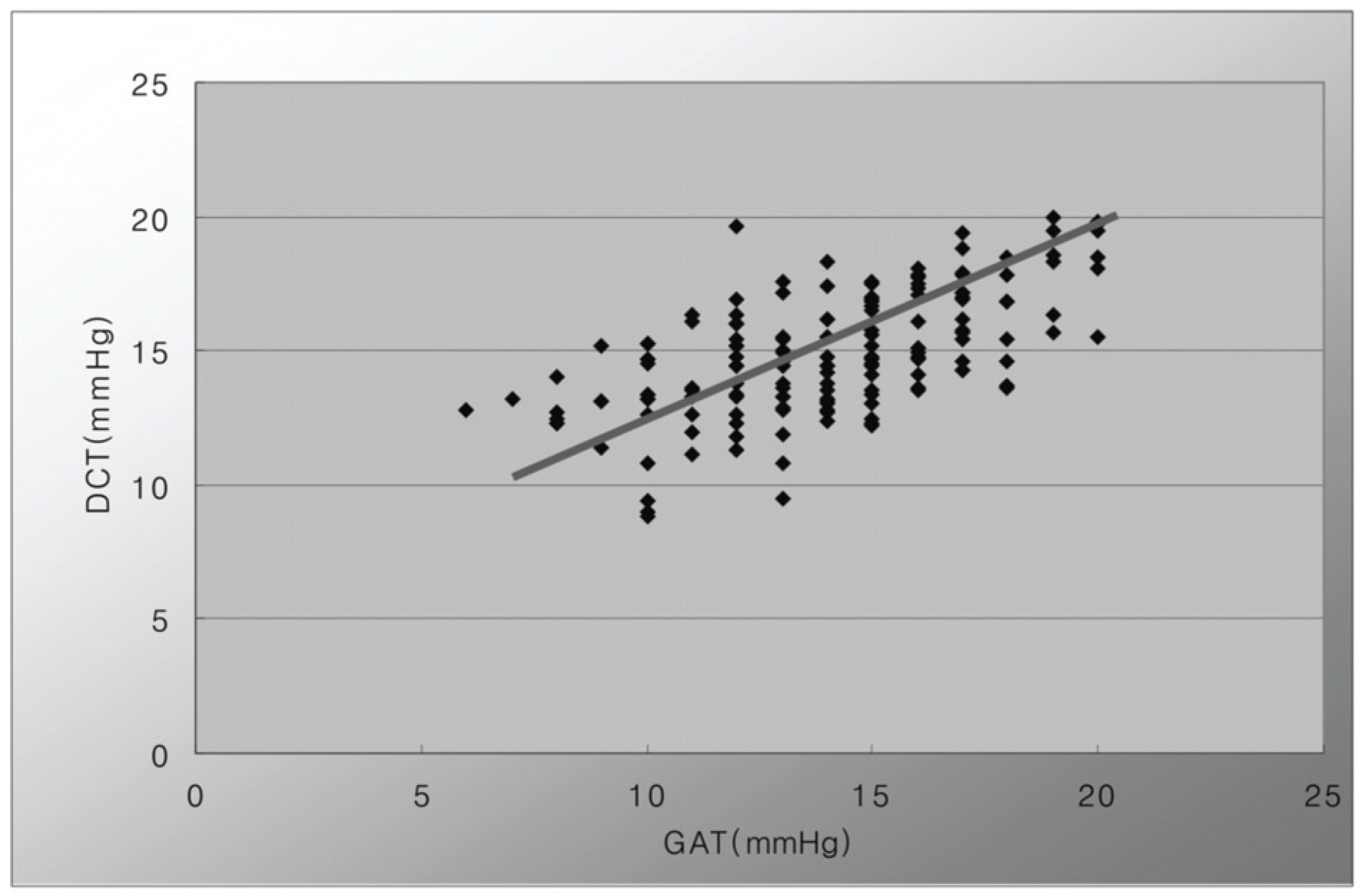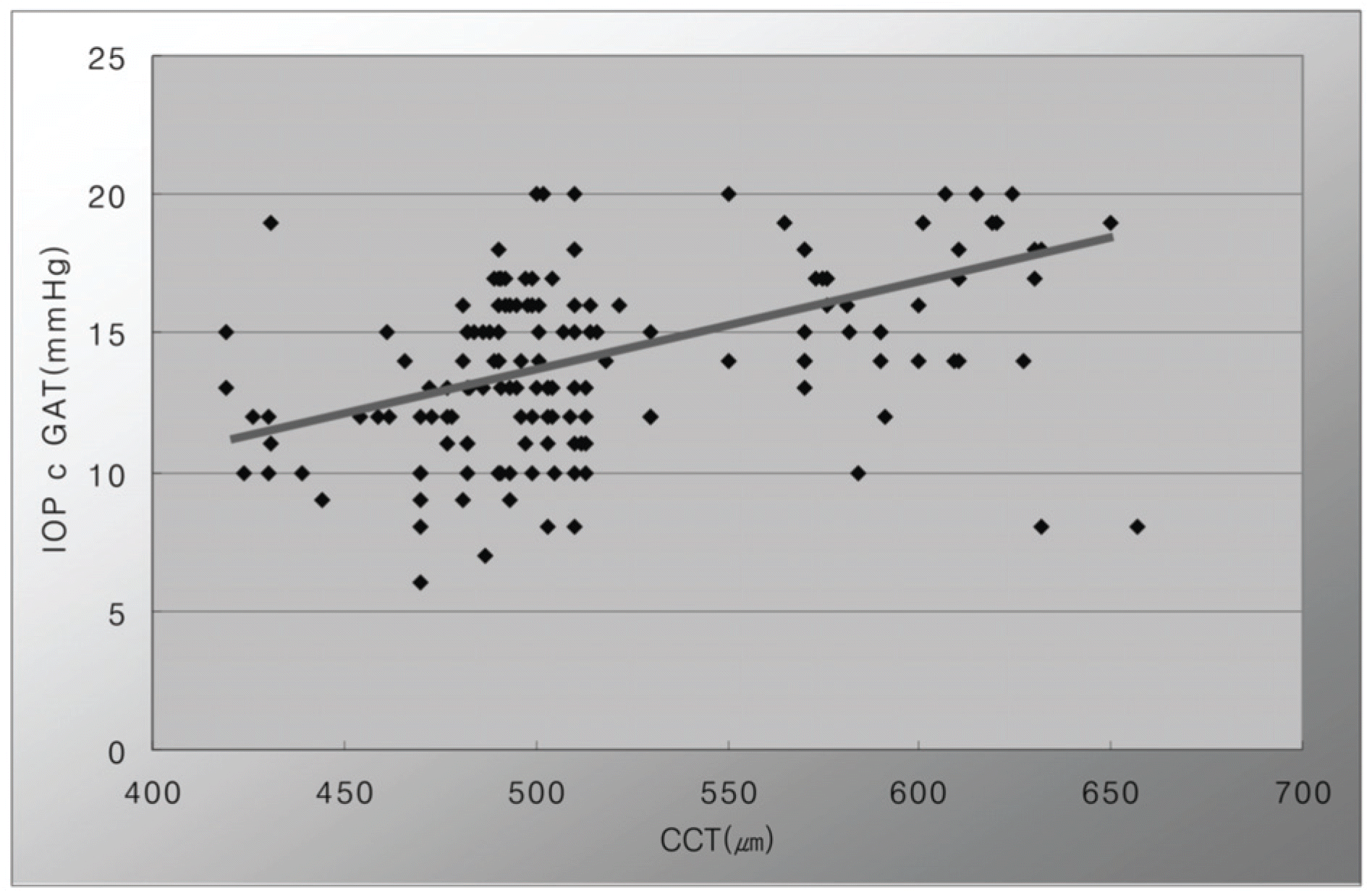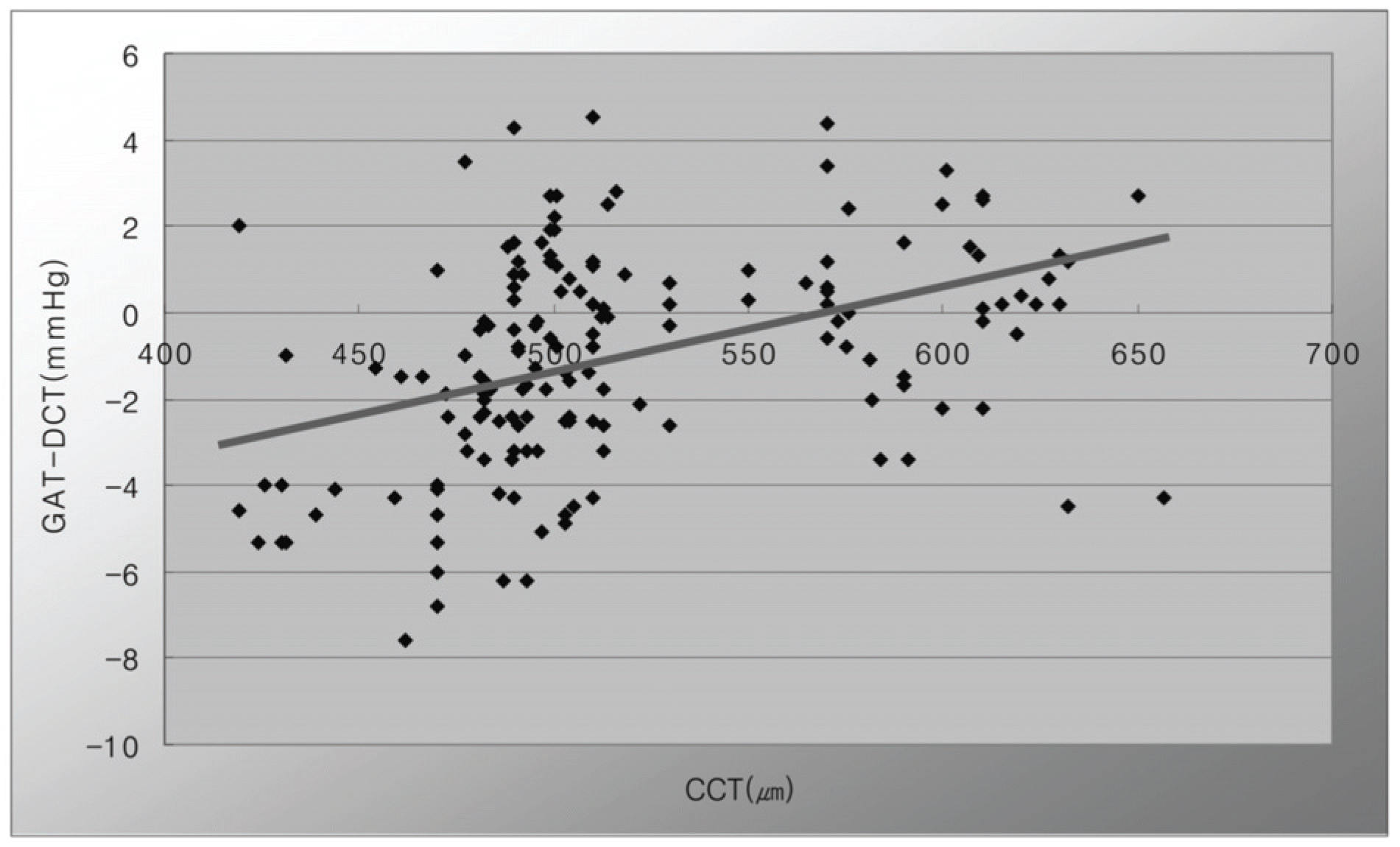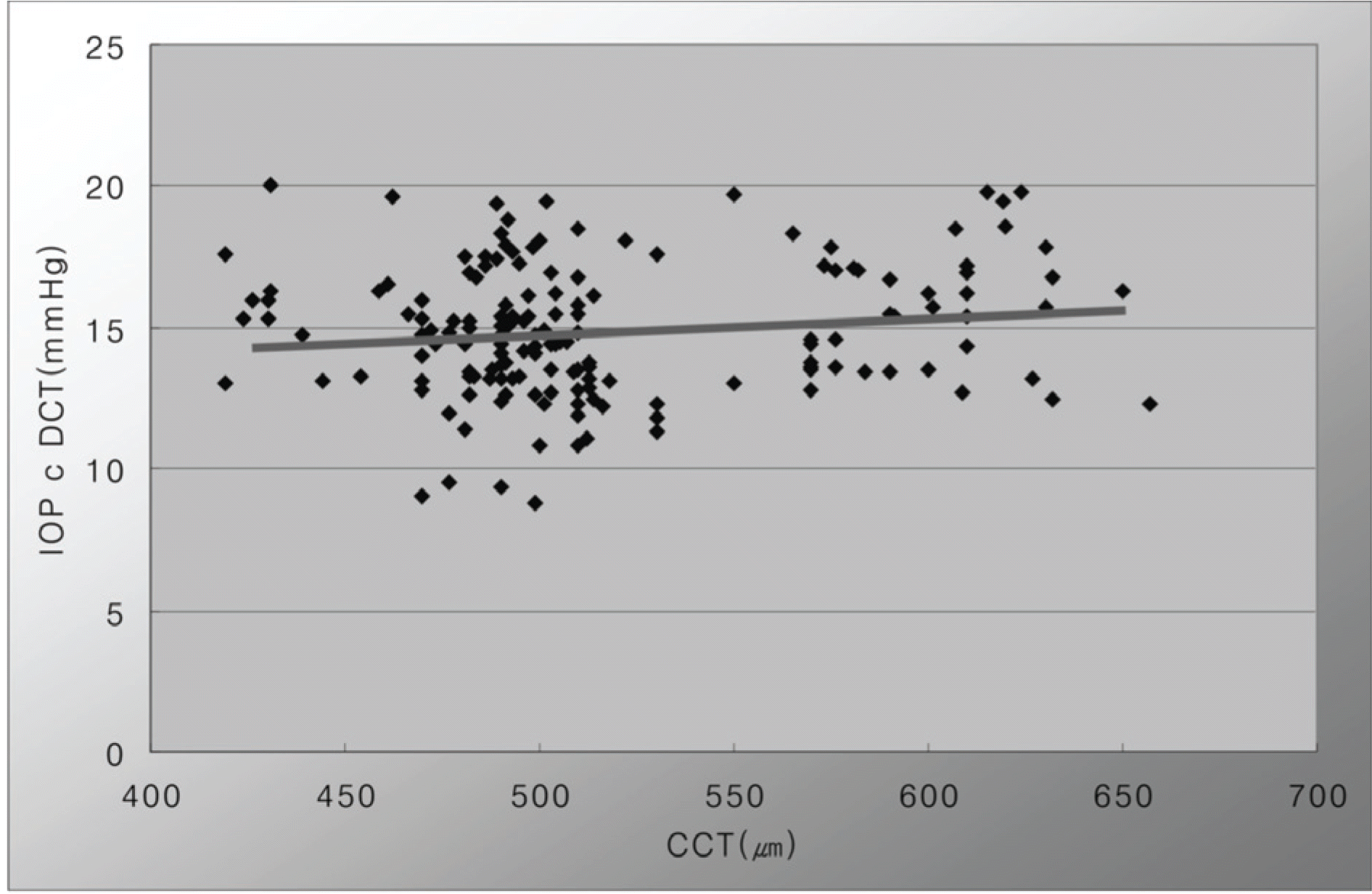Abstract
Purpose
To compare dynamic contour tonometry (DCT) and Goldmann applanation tonometry (GAT) and investigate the influence of central corneal thickness (CCT) onintraocular pressure.
Methods
In a prospective study of 165 eyes with glaucoma (135 eyes), glaucoma suspect (14 eyes), and ocular hypertension (16 eyes), intraocularpressure was measured with DCT and GAT, and followed by measurement of the CCT with ultrasound pachymetry. Statistical analysis were performed with simple linear regression analysis and t-test using SPSS (Statistical software, ver. 10; SPSS Inc., Chicago, IL).
Results
A clear correlation between DCT and GAT was found (r =0.733, p<0.001). The average intraocular pressure was 14.92±2.28 mmHg with DCT and 13.97±3.12 mmHg with GAT, and the intraocular pressure with DCT was 0.95±2.49 mmHg higher than with GAT. A meaningful correlation was shown between GAT and CCT (r2=0.145, p<0.001), but was not demonstrated between DCT and CCT (r2=0.012, p=0.081). In addition, the difference of intraocular pressure between GAT and DCT (GAT-DCT) showed a significant correlation with CCT (r2=0.145, p<0.001).
References
1. Troost R, Vogel A, Beck S, et al. Clinical comparison of two intraocular pressure measurement methods: SmartLens dynamic observing tonography versus Goldmann. Graefes Arch Clin Exp Ophthalmol. 2001; 239:889–92.

2. Whitacre MM, Stein RA, Hassanein K. The effect of corneal thickness on applanation tonometry. Am J Ophthalmol. 1993; 115:592–6.

3. Wolfs RCW, Klaver CC, Vingerling JR, et al. Distribution of central corneal thickness and its association with intraocular pressure: the Rotterdam study. Am J Ophthalmol. 1997; 123:767–72.

4. Doughty MJ, Saman ML. Human corneal thickness and its impact on intraocular pressure measures: a review and meta-analysis approach. Surv Ophthalmol. 2000; 44:367–408.
5. Ehlers N, Bramsen T, Sperling S. Applanation tonometry and central corneal thickness. Acta Ophthalmol (Copenh). 1975; 53:1974–83.

6. Brandt JD, Beiser JA, Kass MA, Gordon MO. Central corneal thickness in the Ocular Hypertension Treatment Study (OHTS). Ophthalmology. 2001; 108:1779–88.

7. Gordon MO, Beiser JA, Brandt JD, et al. The Ocular Hypertension Treatment study: baseline factors that predict the onset of primary open angle glaucoma. Arch Ophthalmol. 2002; 120:714–20.
8. Herndon LW, Allingham R, Choudhri SA, et al. Central corneal thickness innormal, glaucomatous, and ocular hypertensive eyes. Arch Ophthalmol. 1997; 115:1137–41.
9. Siganos DS, Papasterigiou GI, Moedas C. Assessment of the Pascal dynamic contour tonometer in monitoring intraocular pressure in unoperated eyes and eyes after LASIK. J Cataract Refract Surg. 2004; 30:746–51.

10. Kaufman C, Bachmann LM, Thiel MA. Intraocular pressure measurements using dynamic contour tonometry after laser in situ keratomileusis. Invest Ophthalmol Vis Sci. 2003; 44:3790–4.
11. Kaufmann C, Bachmann LM, Thiel MA. Comparison of dynamic contour tonometry with Goldmann applanation tonometry. Invest Ophthalmol Vis Sci. 2004; 45:3118–21.

12. Kniestedt C, Nee M, Stamper RL. Dynamic contour tonometry (DCT) and its dependence on corneal hydration in human cadaver eyes. Arch Ophthalmol. 2004; 122:1287–93.
13. Wirthlin AC, Siganos DD, Papastergiou G, et al. Dynamic contour tonometry for IOP measurement after LASIK, a comparison with Goldmann tonometry. Synopsis of paper presented at DOC, Nurenberg. 2002.
14. Duba I, Wirthlin AC. Dynamic contour tonometry for post-LASIK intraocular pressure measure measurements. Klin Monatsbl Augenheilkd. 2004; 221:347–50.
15. Fresco BB. A new tonometer-the pressure phosphene tonometer: clinical comparison with Goldmann tonometry. Ophthalmology. 1998; 105:2123–6.
16. Whitacre MM, Stein RA, Hassanein K. The effect of corneal thickness on applanation tonometry. Am J Ophthalmol. 1993; 115:592–6.

17. Stodtmeister R. Applanation tonometry and correlation according to corneal thickness. Acta Ophthalmol Scand. 1998; 76:319–24.
18. Velten IM, Bergua A, Horn FK, et al. Central corneal thickness in normal eyes, patients with ocular hypertension, normal-pressure and open-angle glaucomas-a study. Klin Monatsbl Augenheilkd. 2001; 218:466.
19. Ventura AC, Bohnke M, Mojon DS. Central corneal thickness in patients with normal tension glaucoma, primary open angle glaucoma, pseudoexfoliation glaucoma, or ocular hypertension. Br J Ophthalmol. 2001; 85:792–5.
20. Grieshaber MC, Schoetzau A, Zawinka C, et al. Effect of central corneal thickness on dynamic contour tonometry and Goldmann applanation tonometry in primary open-angle glaucoma. Arch Ophthalmol. 2007; 125:740–4.

21. Francis BA, Hsieh A, Lai MY, et al. Los Angeles Latino Eye Study Group. Effects of corneal thickness, corneal curvature, and intraocular pressure level on Goldmann applanation tonometry and dynamic contour tonometry. Ophthalmology. 2007; 114:20–6.
Figure 1.
Pearson correlation of intraocular pressure (IOP) measurements obtained by GAT and DCT (r=0.733, p<0.001). Plot of IOP measurements with GAT against DCT in patients with CCT showing a good correlation between the two methods. GAT= Goldmann applanation tonometer; DCT=dynamic contour tonometer; CCT=central corneal thickness.

Figure 2.
Influence of CCT on IOP measurements. GAT is significantly influenced by CCT (r2=0.145, p<0.001).

Figure 4.
Plot of GAT-DCT difference in IOP against the CCT for all patients showing a tendency to increase the difference between the two measurements for increasingly thinner corneas but not for thick corneas. The difference of IOP between GAT and DCT shows a significant correlation with CCT (r2=0.145, p<0.001).





 PDF
PDF ePub
ePub Citation
Citation Print
Print



 XML Download
XML Download